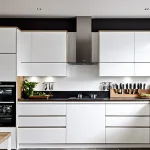The Foundations of UK Kitchen Bar Design
Exploring heritage, style, and cultural roots
The British kitchen heritage is deeply woven into the concept of the kitchen bar, reflecting centuries of domestic life and social gatherings. At its core, this heritage embraces a balance of practicality and warmth, where the kitchen bar serves as more than just a functional space—it embodies a meeting point for family and friends.
In the same genre : Key elements for crafting a contemporary uk kitchen design
Traditional kitchen design in the UK often features materials like rich oak, warm walnut, and painted timber, offering durability alongside a timeless aesthetic. These materials not only highlight craftsmanship but also evoke an inviting atmosphere that complements the kitchen bar’s role. Signature design features include paneled cabinetry, turned wooden legs, and brass fixtures—elements that together celebrate the lineage of British style.
The UK bar traditions go beyond design, holding cultural significance in British homes as a symbol of conviviality. The kitchen bar is where daily routines blend with social rituals, from casual breakfasts to evening drinks. This cultural attachment is rooted in history, where the kitchen bar bridged the gap between cooking and entertaining, making it a cherished feature in many residences. The blend of these design choices and cultural values defines the enduring appeal of UK kitchen bars.
Have you seen this : Boosting kitchen productivity: top strategies for uk restaurants to enhance workflow efficiency
Contemporary Innovations Shaping UK Kitchen Bars
Exploring the latest trends and technologies enhancing kitchen bars
The rise of modern kitchen trends transforms traditional kitchen bars into vibrant, multifunctional spaces. Central to this evolution is the integration of smart technologies—from touch-activated faucets to app-controlled lighting and appliances—that elevate convenience and user interaction. These innovations introduce automation at the bar area, allowing for seamless control of features such as refrigeration, temperature regulation, and even beverage dispensing, ensuring an efficient and engaging experience.
Material choice plays a pivotal role in defining contemporary bar elements. Homeowners increasingly favor glass, steel, and sustainable surfaces, marrying aesthetics with functionality. Glass offers a sleek, reflective finish enhancing light flow, while steel provides durability and an industrial chic look. Meanwhile, eco-conscious materials respond to growing demand for sustainability without compromising style, reflecting a broader commitment within modern kitchen trends to environmentally responsible design.
Furthermore, the layout of kitchen bars is adapting to suit open-plan living. These evolving layouts promote social interaction by blending the kitchen bar with dining and lounge areas, creating a hub for entertaining and everyday life. Modular and flexible configurations allow users to reconfigure space as needed, exemplifying the contemporary emphasis on versatility within kitchen design. This progression underscores how innovative kitchen technology and material advances coexist to shape the future of kitchen bars across the UK.
Achieving the Balance: Merging Tradition with Innovation
Blending heritage and innovation within a kitchen bar setting requires intentional design strategies that respect the past while embracing the future. Transitional kitchen design expertly mixes old and new elements to produce a cohesive and inviting space. This approach uses classic materials like wood or stone alongside sleek modern fixtures, creating a dialogue between tradition and technology.
Successful kitchen bar transformations often feature a harmonious combination of antique cabinetry paired with contemporary lighting or minimalist hardware. For instance, retaining original woodwork while installing state-of-the-art appliances exemplifies how to blend heritage and innovation effectively. This not only preserves character but also upgrades functionality.
Interior design experts recommend focusing on contrast and complementarity. Using neutral palettes with pops of vibrant colors can bridge eras gracefully. Additionally, incorporating versatile kitchen islands or bars made from reclaimed materials adds authenticity while accommodating modern usage patterns. Such thoughtful integration ensures the space feels timeless yet relevant.
By strategically mixing classic architectural details with innovative design solutions, homeowners can achieve a transitional kitchen design that respects history without sacrificing convenience or style. The key lies in balancing form and function to create a welcoming atmosphere that honors tradition with a fresh twist.
Inspiration and Practical Tips for Homeowners
Finding the right kitchen bar inspiration can transform a simple cooking area into a vibrant social hub. In the UK, where home design trends blend traditional charm with modern sensibilities, it’s essential to strike a balance. Expert advice on kitchen spaces consistently highlights the value of selecting features that enhance both style and functionality.
When sourcing authentic and modern kitchen bar features, consider materials that offer durability alongside aesthetic appeal. Wood with natural finishes exudes warmth, while metal accents provide a contemporary edge. Mixing textures can elevate the bar’s character while ensuring it remains practical for everyday use. For example, incorporating a stone countertop paired with bespoke lighting creates an inviting atmosphere without sacrificing utility.
To enhance functionality without losing character, integrating smart storage solutions is crucial. Pull-out racks, concealed cabinets, and multi-purpose seating optimize space in a kitchen bar without cluttering the design. UK home design tips emphasize using these clever layouts to maintain a seamless flow between cooking, dining, and entertaining zones.
Top tips for maintaining a timeless yet current design include investing in versatile color palettes and fixtures that complement evolving trends. Neutral tones with pops of bold colors keep the space fresh. Regular upkeep, such as sealing natural surfaces and updating hardware, ensures the kitchen bar remains a standout feature, regardless of changing styles.
By focusing on these expert insights, homeowners can craft kitchen bars that are both inspirational and practical, perfectly suited for modern UK living.

